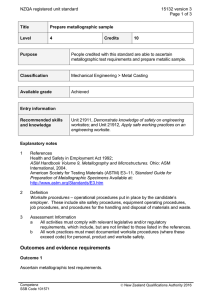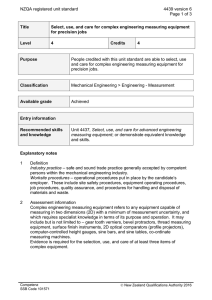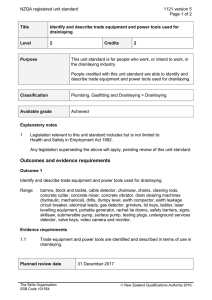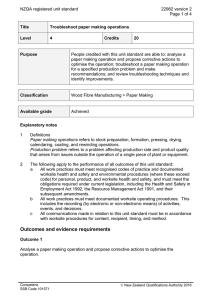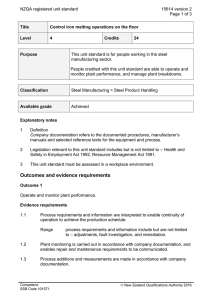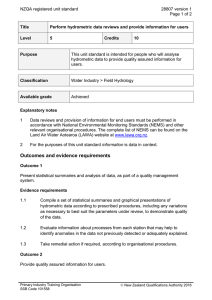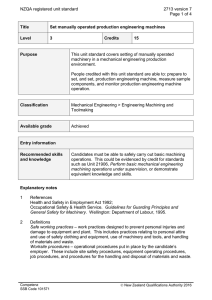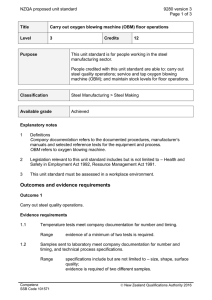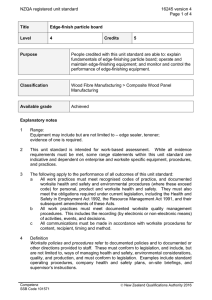NZQA registered unit standard 15131 version 3 Page 1 of 3
advertisement
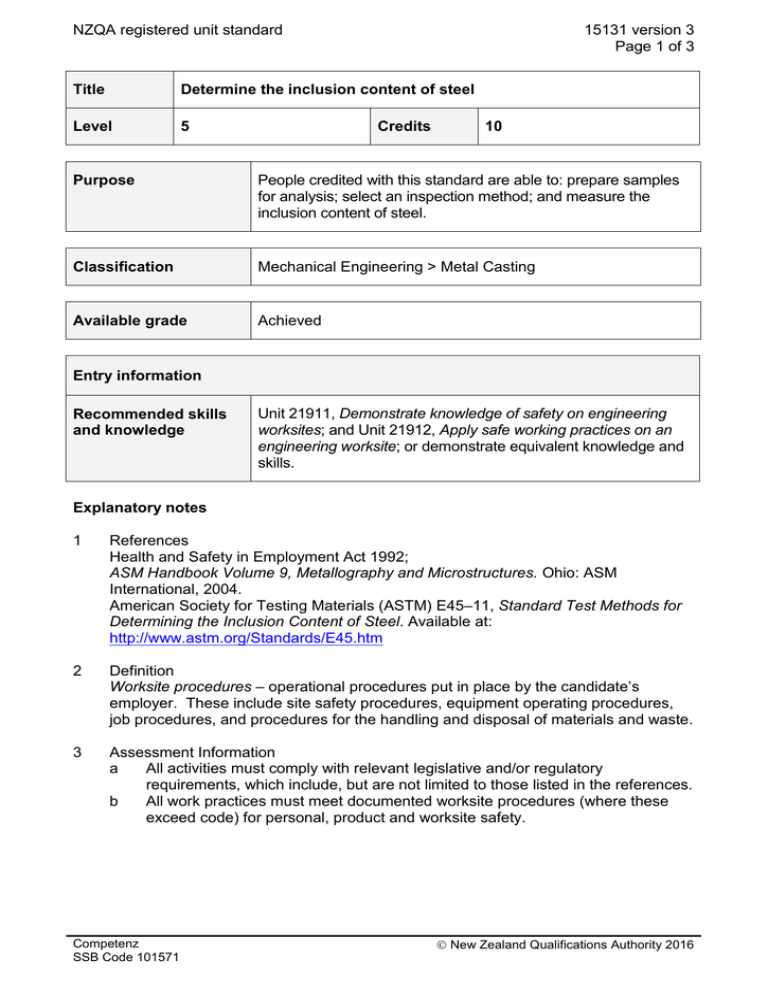
NZQA registered unit standard 15131 version 3 Page 1 of 3 Title Determine the inclusion content of steel Level 5 Credits 10 Purpose People credited with this standard are able to: prepare samples for analysis; select an inspection method; and measure the inclusion content of steel. Classification Mechanical Engineering > Metal Casting Available grade Achieved Entry information Recommended skills and knowledge Unit 21911, Demonstrate knowledge of safety on engineering worksites; and Unit 21912, Apply safe working practices on an engineering worksite; or demonstrate equivalent knowledge and skills. Explanatory notes 1 References Health and Safety in Employment Act 1992; ASM Handbook Volume 9, Metallography and Microstructures. Ohio: ASM International, 2004. American Society for Testing Materials (ASTM) E45–11, Standard Test Methods for Determining the Inclusion Content of Steel. Available at: http://www.astm.org/Standards/E45.htm 2 Definition Worksite procedures – operational procedures put in place by the candidate’s employer. These include site safety procedures, equipment operating procedures, job procedures, and procedures for the handling and disposal of materials and waste. 3 Assessment Information a All activities must comply with relevant legislative and/or regulatory requirements, which include, but are not limited to those listed in the references. b All work practices must meet documented worksite procedures (where these exceed code) for personal, product and worksite safety. Competenz SSB Code 101571 New Zealand Qualifications Authority 2016 NZQA registered unit standard 15131 version 3 Page 2 of 3 Outcomes and evidence requirements Outcome 1 Prepare samples for analysis. Evidence requirements 1.1 Statistical sampling plan is obtained from worksite procedures to meet the production lot size. 1.2 Samples are taken from the production lot in accordance with the statistical sampling plan. 1.3 Sample position and orientation data are recorded. Outcome 2 Select an inspection method. Evidence requirements 2.1 Test method is selected (based on steel production route and expected end use) in accordance with ASTM E45–11. Range 2.2 macroscopic method >40m – macro-etch, fracture, step down; magnetic particle method and/or microscopic methods <40m – methods A, B, C, D, E of ASTM E45–11. Equipment selected is consistent with sample type and test method. Range the equipment may include but is not limited to – microscope, stereo microscope, magnetic particle equipment, camera, rating charts. Outcome 3 Measure the inclusion content of steel. Evidence requirements 3.1 Specimens are checked to verify that sample preparation is in accordance with inspection method requirements. 3.2 Analysis and rating of specimen are consistent with the morphology and likely source of inclusions. Range 3.3 morphology – size, shape, location, distribution; type and/or source of inclusions – deoxidation, exogenous, carbide, reoxidation. Rating is recorded for each separate analysis on each specimen. Competenz SSB Code 101571 New Zealand Qualifications Authority 2016 NZQA registered unit standard Planned review date 15131 version 3 Page 3 of 3 31 December 2014 Status information and last date for assessment for superseded versions Process Version Date Last Date for Assessment Registration 1 25 July 1999 31 December 2012 Review 2 19 May 2006 N/A Rollover and Revision 3 17 November 2011 N/A Consent and Moderation Requirements (CMR) reference 0013 This CMR can be accessed at http://www.nzqa.govt.nz/framework/search/index.do. Please note Providers must be granted consent to assess against standards (accredited) by NZQA, before they can report credits from assessment against unit standards or deliver courses of study leading to that assessment. Industry Training Organisations must be granted consent to assess against standards by NZQA before they can register credits from assessment against unit standards. Providers and Industry Training Organisations, which have been granted consent and which are assessing against unit standards must engage with the moderation system that applies to those standards. Requirements for consent to assess and an outline of the moderation system that applies to this standard are outlined in the Consent and Moderation Requirements (CMR). The CMR also includes useful information about special requirements for organisations wishing to develop education and training programmes, such as minimum qualifications for tutors and assessors, and special resource requirements. Comments on this unit standard Please contact Competenz qualifications@competenz.org.nz if you wish to suggest changes to the content of this unit standard. Competenz SSB Code 101571 New Zealand Qualifications Authority 2016
